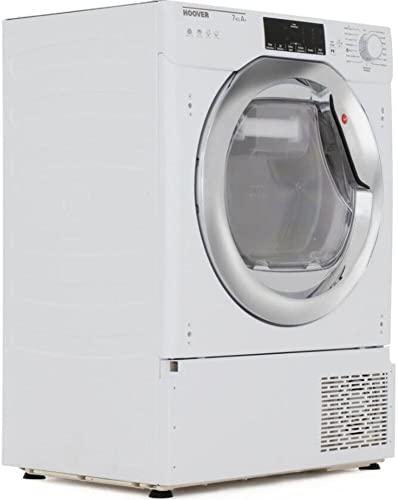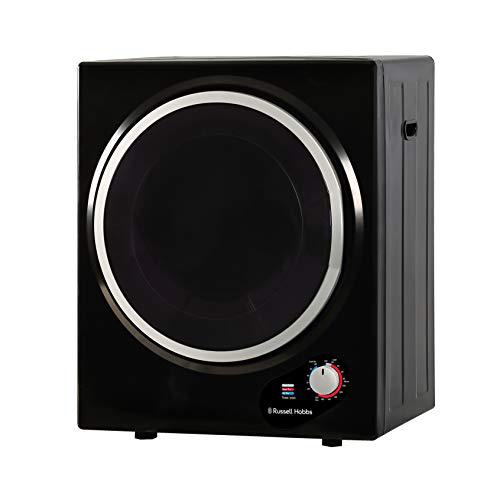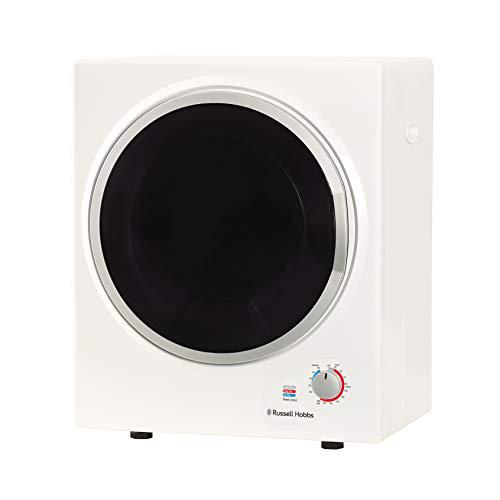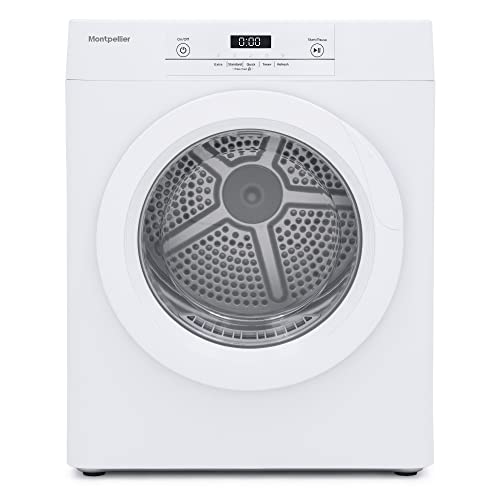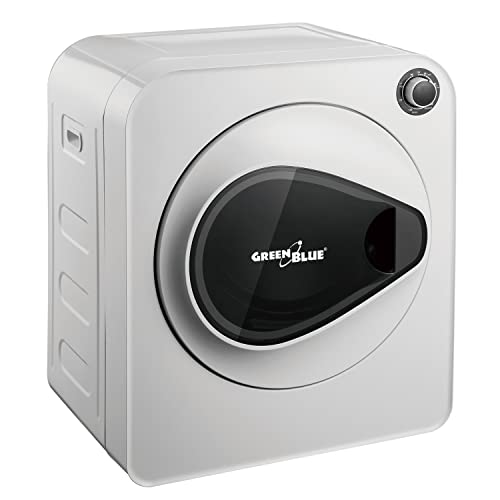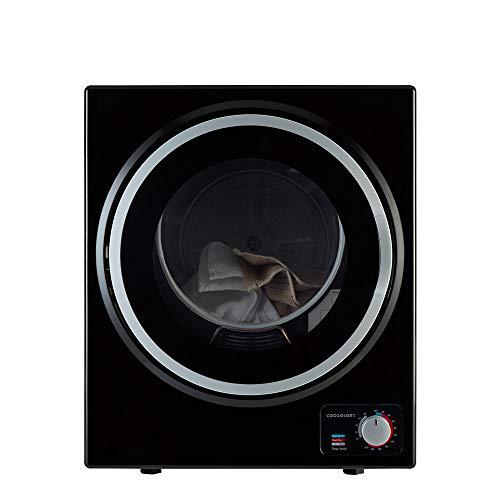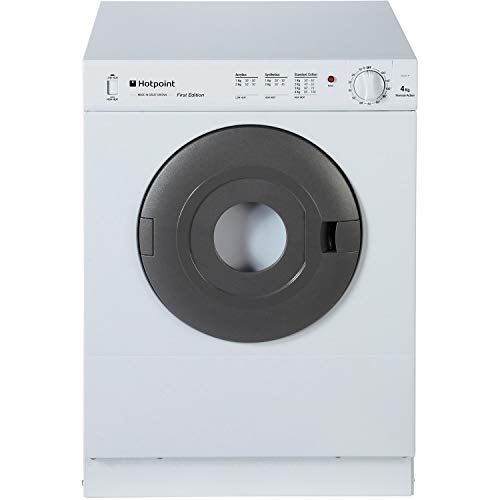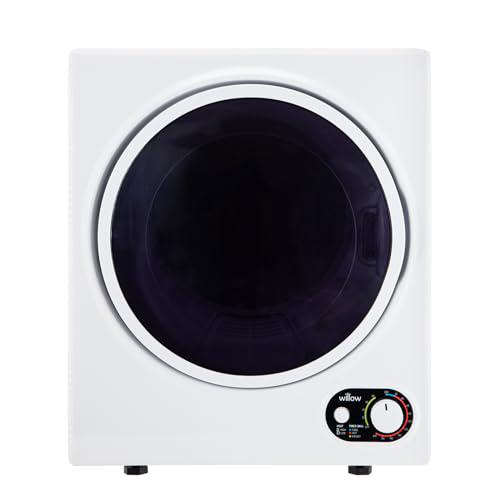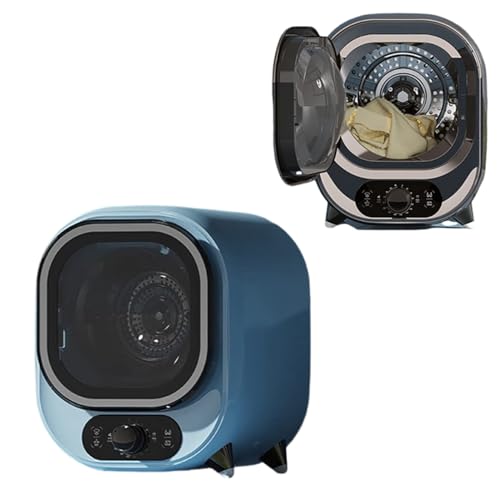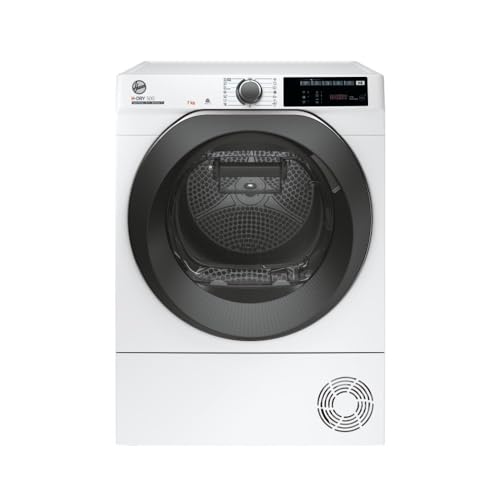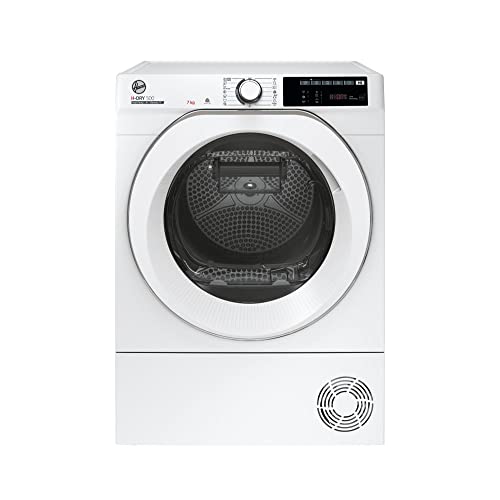How deep are slim tumble dryers?
Slim tumble dryers have a depth of 50 cm or less. Super-slim tumble dryers have a depth of 45 cm or less.
Are slim tumble dryers good?
Slim tumble dryers are a good choice if you need a compact model that fits in small spaces. They work like standard dryers but take up less room. Some models use heat pump technology, which reduces energy consumption. Super-slim models (45 cm or less) save even more space but may have a smaller drum capacity.
The best slim tumble dryers (with the highest overall score) are as follows.
- Hoover H-DRY 300 BATDH7A1TCE (Overall score: 7.44 points; Depth: 49.2 cm)
- Russell Hobbs RH3VTD800B (Overall score: 4.99 points; Depth: 41.5 cm)
- Russell Hobbs RH3VTD800B (Overall score: 4.99 points; Depth: 41.5 cm)
Note: Products currently available are listed first.
What are the main advantages of slim tumble dryers?
Slim tumble dryers have the following advantages over other dryers:
- All dryer types available: Slim tumble dryers include heat pump, condenser, and vented models.
- Lower price: Slim tumble dryers cost about £230 less than the market average (£250 vs £480).
- More compact: Slim tumble dryers take up about 50% less space than non-slim models (0.14 m³ vs 0.31 m³).
- Lighter weight: Slim tumble dryers weigh about 25 kg less than the market average (20 kg vs 45 kg).
- Advanced features: Most normal-size slim tumble dryers include humidity sensors, a laundry detection system, a delay start option, selectable drying levels, a memory function, Wi-Fi connectivity, Bluetooth, an ECO indicator, and smart diagnosis.
- Crease reduction: All normal-size slim tumble dryers use bidirectional drum movement, and most also have a post-drying movement feature to reduce creases.
What are the main disadvantages of slim tumble dryers?
Slim tumble dryers have the following disadvantages compared to other dryers:
- Fewer heat pump models: Only 28% of slim tumble dryers use heat pump technology, while 71% of all tumble dryers do.
- Worse energy efficiency: About 31% of all tumble dryers belong to energy class A+++, but no slim tumble dryer has this rating.
- No inverter motor: We have not found any slim tumble dryer equipped with an inverter motor.
- Fewer special cycles: Allergy, Duvet, Bed Linen, and Hygiene cycles are less common in slim tumble dryers than in most other models.
- Limited drying functions: No slim tumble dryer includes gentle drying or silent function, and very few have a fast function.
- Missing design features: No slim tumble dryer includes antivibration design, a reversible door, or an interior light.
- Fewer features and programs: Small-size slim tumble dryers have about 1-2 advanced features (compared to the market average of 9) and only 3-5 drying programs (compared to 14).

How much do slim tumble dryers cost?
Slim tumble dryers cost between £100 and £600, with an average price of £250, which is £230 cheaper than the market average of £480.
To compare different types, slim tumble dryers have the following price differences:
- Slim air vented dryers: The cheapest type, with an average price of £200.
- Slim condenser dryers: More expensive, with an average price of £310.
- Slim heat pump dryers: The most expensive type, with an average price of £510.
The following chart shows the price distribution for slim dryers.
[vertical-chart-10401011252114103]
What should you consider while choosing the best slim tumble dryer?
When choosing the best slim tumble dryer, you should consider the following factors:
- Drying technology: Slim tumble dryers come in heat pump, condenser, and vented models. Heat pump dryers consume less energy but cost more.
- Energy efficiency: Most slim tumble dryers have lower energy ratings than standard models, and none belong to class A+++.
- Noise level: Some slim tumble dryers operate at lower noise levels, but none include a silent function.
- Features and programs: Small-size slim tumble dryers have about 1-2 advanced features (compared to 9 on average) and 3-5 drying programs (compared to 14). Fewer models include special cycles like Allergy, Duvet, Bed Linen, or Hygiene.
- Drum movement: All normal-size slim tumble dryers use bidirectional drum movement, and most have a Post-drying movement feature to reduce creases.
- Design elements: No slim tumble dryer includes antivibration design, a reversible door, or an interior light.
- Price range: Prices range from £100 to £600, with an average of £250, which is £230 cheaper than the market average of £480. Among slim dryers, air vented models cost about £200 on average, condenser models £310, and heat pump models £510.
What is the most common type of slim tumble dryers?
Most slim tumble dryers are air-vented models (66%), followed by heat pump dryers (28%) and condenser dryers (7%).
Air-vented dryers are the most common because they have a simpler design and require fewer components than condenser or heat pump models. Without extra parts like condensers or heat pumps, they are lighter and easier to design in a slim format.
The following are the main advantages of each type:
- Air-vented dryers: Affordable and easy to use, with an average price of £200. They dry clothes quickly by expelling moist air outside through a vent, so they work best in homes with an external wall for ventilation. Their lightweight and straightforward design also makes installation and maintenance easier.
- Heat pump dryers: The most energy-efficient option, as they recycle hot air to dry clothes at lower temperatures, which protects fabrics and lowers energy consumption. They suit eco-conscious users and those drying delicate garments. Although they have a higher initial price, long-term energy savings balance the cost.
- Condenser dryers: No external vent is needed since they collect moisture in a tank or drain it away, so they can be used in any room. They retain heat better during operation and are often quieter, making them suitable for indoor spaces with limited ventilation.
Overall, heat pump technology has the most advantages. These dryers have the highest initial cost, but they are much more energy efficient, so the investment pays off in a few years.
What capacities are available for slim tumble dryers?
Slim tumble dryers have capacities ranging from 2.5 to 8 kg. However, many models are available only in smaller sizes (2-4 kg), and there are few standard-sized slim dryers on the market.
Drum volume in slim dryers varies from 18 to 125 litres, with an average of 90 litres—28 litres less than the market average of 118 litres.
Slim dryers are compact, occupying between 0.12 and 0.24 m³. The average size is about 0.14 m³, which means they take up roughly 50% less space than non-slim tumble dryers.
Weight varies from 17 to 38 kg. On average, slim dryers weigh about 25 kg less than standard models (20 kg vs 45 kg). Comparing types, slim heat pump dryers weigh on average 38 kg, condenser dryers 29 kg, and air-vented dryers 17 kg.
The chart below illustrates the capacity distribution for slim dryers.
[pie-chart-972579986112147]
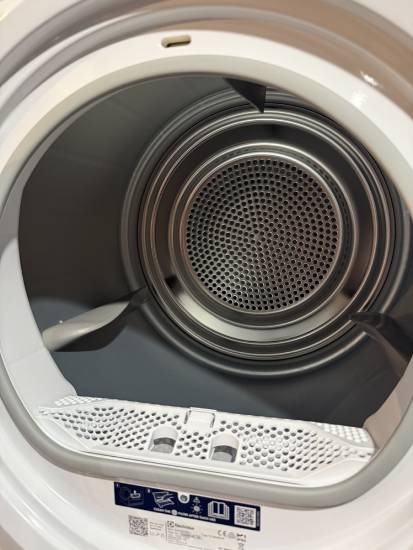
How energy-efficient are slim tumble dryers?
Slim tumble dryers have energy classes ranging from A++ to F. About 12% belong to class A++, 27% to class A+, 58% to class C, and 4% to class F. There are no slim dryers in class A+++ or B.
In general, slim dryers have worse energy classes than the overall market, where 31% of all tumble dryers are A+++, 36% are A++, 5% are A+, 18% are B, and 9% are C.
Slim heat pump dryers consume 1.8 to 2.25 kWh per cycle in full load (average 2.25 kWh, higher than the market average of 1.93 kWh) and 0.9 to 1.2 kWh per cycle in half load (average 1.2 kWh, higher than the market average of 1.1 kWh). Their annual energy consumption ranges from 210 to 270 kWh, with an average of 269 kWh—higher than the market average of 235 kWh.
Slim condenser dryers consume about 3.5 kWh per cycle in full load and 1.88 kWh per cycle in partial load.
Slim air-vented dryers consume 1.93 kWh per cycle in full load and 1.07 kWh per cycle in partial load. Although air-vented dryers typically use more energy than the market average, slim models have smaller capacities (2.5 to 4 kg), so they require more cycles to dry the same amount of clothes, increasing energy consumption per kg of laundry.
Water recovery efficiency in slim dryers is usually class B. There are no models in class A or C. This is lower than the market average, where 23% of dryers belong to class A, 67% to class B, and 9% to class C.
Energy efficiency classes for slim dryers are represented in the following chart.
[pie-chart-17580217394016813]
How loud are slim tumble dryers?
Slim tumble dryers have noise levels ranging from 35 to 67 dB, with an average of 65 dB, the same as the market average.
How many drying programs do slim tumble dryers offer?
Slim tumble dryers typically have 15 drying programs, similar to most standard tumble dryers. However, smaller slim models usually have only 3 to 5 programs.
Most slim dryers include basic drying programs such as Cottons, Synthetics, and Mix. Smaller slim models often feature Cool, Heat, and Air Dry instead.
The following specialized programs are commonly found in slim tumble dryers:
- Refresh: 83%
- Shirt: 31%
- Jeans: 31%
- Outdoor/Sport: 28%
- Wool: 31%
Some cycles are less common in slim dryers than in most other tumble dryers:
- Allergy: 14% (vs. 31% market share overall)
- Duvet: 3% (vs. 48%)
- Bed linen: 7% (vs. 38%)
- Hygiene: 10% (vs. 34%)
Eco cycles in slim dryers run between 110 and 240 minutes, with an average of 140 minutes, shorter than the market average of 190 minutes.
Cycle duration varies by type: slim heat pump dryers take an average of 245 minutes, condenser dryers 180 minutes, and air-vented dryers 125 minutes.
The number of washing programs available in slim dryers is displayed in the chart below.
[vertical-chart-18869819356717792]
Which drying functions do slim tumble dryers have?
Slim tumble dryers do not include gentle drying or silent functions. Very few models (3%) have a fast function.
What features do slim tumble dryers include?
Normal-size slim tumble dryers typically include 14 to 16 advanced features, while most small slim dryers have only 1 or 2—much fewer than the market average of 9 features.
Most normal-size slim dryers include features such as humidity sensors, laundry detection system, Delay start option, selectable drying level, memory function, Wi-Fi connectivity, Bluetooth, ECO indicator, and smart diagnosis. Small slim dryers do not have any of these features.
A few normal-size slim dryers (22%) include a special drum design. Small models do not have this feature.
No slim dryers include antivibration design, reversible door, or interior light.
Most normal-size slim dryers have a post-drying movement feature, which prevents creases when clothes are left inside after the cycle finishes. They also perform bidirectional movement, which helps prevent clothes from tangling and bunching up during drying. Small slim dryers do not include these features.
No slim tumble dryers have an inverter motor.

